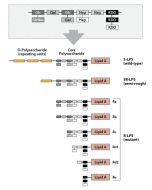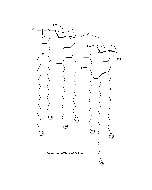Cookie Policy: This site uses cookies to improve your experience. You can find out more about our use of cookies in our Privacy Policy. By continuing to browse this site you agree to our use of cookies.
Innaxon
Lipid A from E. coli R515 (Re) TLRpure Sterile Solution

| Product Details | |
|---|---|
| Synonyms | Lipid A derived from E. coli R515 (Re) LPS (biosynthetic) |
| Product Type | Chemical |
| Properties | |
| Source/Host Chemicals | Isolated and purified from E. coli strain R515. |
| Purity Chemicals | Ultrapure. No detectable DNA, RNA and protein traces. |
| Formulation | Liquid. Colourless opaque aqueous solution. |
| Concentration | 1mg/ml (0.5mg/ml for 250µg size) stabilised in sterile, double-distilled water (ddWater), without any additives. |
| Biological Activity |
Optimal concentration is dependent upon cell type, species, desired activation and analysis: 0.1-1.0μg/ml. Does not activate any TLR other than TLR4 as tested up to 50μg/ml in relevant cellular systems (macrophages). |
| Declaration | Manufactured by Innaxon. |
| Other Product Data |
TLRpure™: • Qualified Purity & Activity • High potency TLR4-specific Ligands • Ultrapure (no detectable protein, RNA and DNA) • Tested on TLR4 KO murine macrophages • Standardised Aqueous Sterile Solutions • No purification or hazardous solubilisation • Excellent lot-to-lot consistency |
| Shipping and Handling | |
| Shipping | AMBIENT |
| Short Term Storage | +4°C |
| Long Term Storage | +4°C |
| Handling Advice |
Do not freeze. Ready-made solution is cell culture-grade. Prepare diluted Lipid A working solutions in water just prior to use, keep sterile. To yield a 100μg/ml (1,000-100x) stock solution add 100μl of Lipid A to 900μl endotoxin-free and sterile ddWater (Cat. No.: IAX-900-002) (not PBS) and mix well. |
| Use/Stability | Stable for at least 2 years after receipt when stored at +4°C. |
| Documents | |
| MSDS |
 Download PDF Download PDF |
| Product Specification Sheet | |
| Datasheet |
 Download PDF Download PDF |
Activation of cells by LPS is mediated by the Toll-like receptor 4 (TLR4), a member of the highly conserved protein family of TLRs, which are specialised in the recognition of microbial components. In mice, defects in TLR4 result in LPS unresponsiveness. For optimal interaction with LPS, TLR4 requires association with myeloid differentiation protein 2 (MD-2). According to current consensus activation of TLR4 is preceded by the transfer of LPS to membrane-bound (m) or soluble (s) CD14 by LPS-binding protein (LBP). This mechanism is believed to be generally true for LPS signaling. Re-form LPS and lipid A, but not S-form LPS, are capable of inducing TNF-α responses also in the absence of CD14. LPS, synthesized by most wild-type (WT) Gram-negative bacteria (S-form LPS), consists of three regions, the O-polysaccharide chain, which is made up of repeating oligosaccharide units, the core oligosaccharide and the lipid A, which harbors the endotoxic activity of the entire molecule. R-form LPS synthesized by the so-called rough (R) mutants of Gram-negative bacteria lacks the O-specific chain. Furthermore, the core-oligosaccharide may be present in different degrees of completion, depending on the class (Ra to Re) to which the mutant belongs. Monophosphoryl Lipid A (MPLA) represents a detoxified derivative of Lipid A and constitutes an important adjuvant in prophylactic and therapeutic vaccines.
- A new method for the extraction of R lipopolysaccharides: C. Galanos, et al.; Eur. J. Biochem. 9, 245 (1969)
- Preparation and properties of antisera against the lipid-A component of bacterial lipopolysaccharides: C. Galanos, et al.; Eur. J. Biochem. 24, 116 (1971)
- Endotoxic properties of chemically synthesized lipid A part structures. Comparison of synthetic lipid A precursor and synthetic analogues with biosynthetic lipid A precursor and free lipid A: C. Galanos, et al.; Eur. J. Biochem. 140, 221 (1984)
- Lipopolysaccharides: structural principles and biologic activities: O. Luederitz, et al.; Rev. Infect. Dis. 6, 428 (1984)
- Synthetic and natural Escherichia coli free lipid A express identical endotoxic activities: C. Galanos, et al.; Eur. J. Biochem. 148, 1 (1985)









